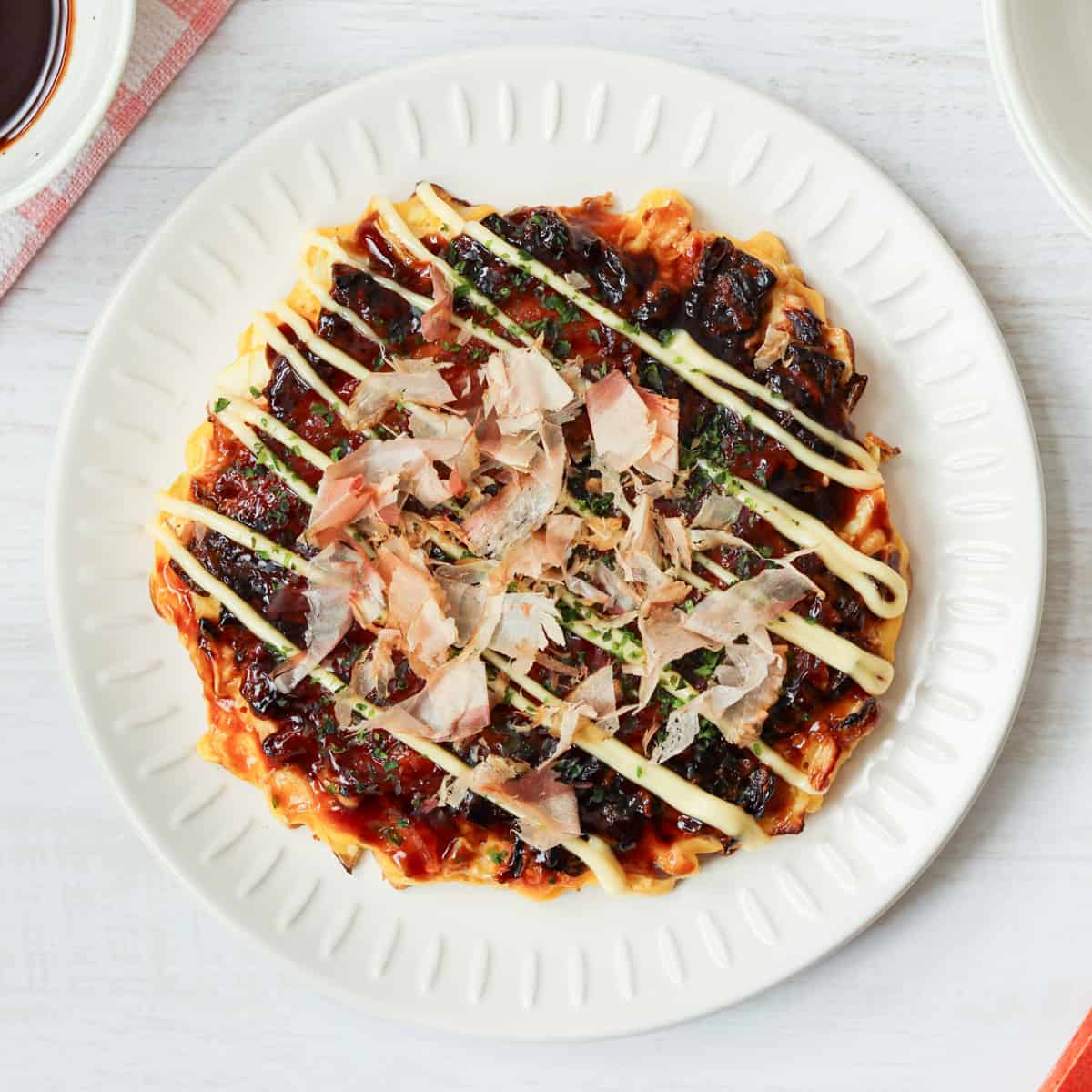
Authentic Osaka-Style Okonomiyaki
This is my special recipe for Okonomiyaki, which I have perfected over time as a resident of Osaka, the birthplace of the dish. It has a light and airy texture on the inside while becoming crispy on the outside, and the batter itself is flavorful without relying too heavily on the sauce.
Print Recipe
Pin Recipe
Servings: 2
Ingredients
- 9.2 oz green cabbage
- 2 tsp beni shoga (red pickled ginger) (optional)
- 2 Tbsp tenkasu (tempura bits)
- 2 large eggs (about 2.1 oz/60 g each, including shell)
- 4.2 oz thinly sliced pork belly
Bonito dashi for okonomiyaki:
- 1 cup water
- ⅔ cup bonito flakes (katsuobushi)
- ¼ tsp salt
Okonomiyaki sauce:
- 3 Tbsp Japanese Worcestershire sauce (such as Kagome or Bull-Dog brand)
- 2 ½ Tbsp ketchup (0.6 oz/17 g per 1 Tbsp)
- 1 ⅓ Tbsp sugar
For the batter:
- ⅚ cup all-purpose flour (plain flour)
- 1 tsp baking powder
Toppings:
- Japanese mayonnaise (such as Kewpie Mayo. For a homemade version, please refer to the linked article.)
- aonori (dried green seaweed flakes)
- bonito flakes (katsuobushi)
Instructions
To make bonito dashi for okonomiyaki:
- Put water in a pot and bring it to a boil. Once boiling, reduce the heat to low, add bonito flakes, and let it simmer for 3 minutes.
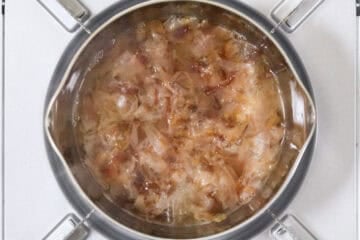
- Turn off the heat and strain the mixture through a fine mesh sieve into a bowl or measuring cup. The bonito dashi for okonomiyaki is ready. Stir in salt, then let the mixture sit until it cools, about 30 minutes. (If you are not using it right away, store it in the refrigerator.)
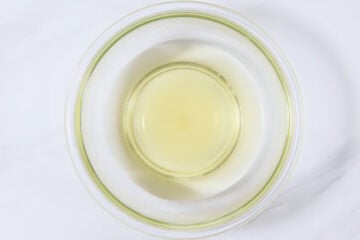
To make okonomiyaki sauce:
- In a small bowl, mix Japanese Worcestershire sauce, ketchup, and sugar. Loosely cover the bowl with plastic wrap or a microwave-safe lid, and microwave it on medium power (500-600W) for 30 seconds. Okonomiyaki sauce is ready.

To make okonomiyaki:
- Coarsely chop the cabbage. Finely chop the beni shoga. Cut the pork belly into 4-inch (10 cm) lengths.
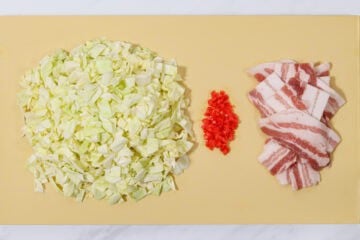
- In a large bowl, lightly combine flour and baking powder with the cooled bonito dashi (⅔ cup/160 ml per 2 servings) until smooth. Divide the combined batter evenly into small bowls, one for each serving. On top of the batter in each bowl, place the chopped cabbage, beni shoga, tenkasu, and a cracked egg.Important: Do not mix the contents of each bowl at this stage, as mixing now will cause the cabbage to release moisture, resulting in a soggy okonomiyaki.
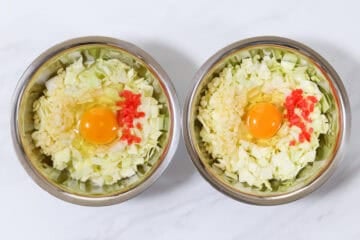
- (Cook one serving per pan unless you have a large griddle.) Heat oil in a pan over medium heat. Once the pan is hot, quickly mix the contents of one serving bowl until the egg yolk is lightly but uniformly blended. Pour the mixture into the pan and shape it into a round about ⅘ inch (2 cm) thick using a spatula. Arrange the pork on top, overlapping as little as possible, and cook for about 5 minutes.
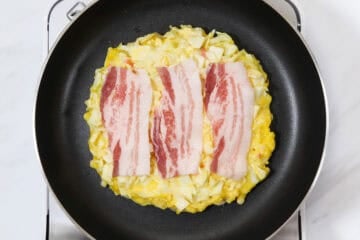
- Once the underside is crisp and browned, carefully flip it over with a spatula and cook the pork side for about 5 minutes.
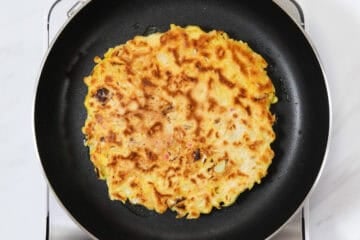
- Once the pork side is nicely browned, carefully flip it over again. Continue cooking for about 1 more minute to let it absorb the pork fat.
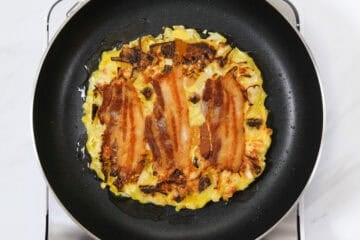
- Serve on a plate, spread with the okonomiyaki sauce, and top with Japanese mayonnaise, aonori, and bonito flakes to taste. Continue cooking the next okonomiyaki.
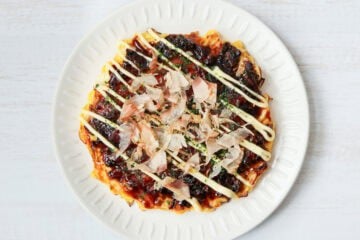
Notes
- The total time is 55 minutes per serving. The cooking time increases by about 13 minutes for each additional serving, unless you have a large griddle.
- If you already have okonomiyaki sauce, skip step 3.
- You can store it in the refrigerator for up to 2 days.
Nutrition
Calories: 762.41kcal Carbohydrates: 71.62g Protein: 19.72g Fat: 44.18g Saturated Fat: 14.23g Polyunsaturated Fat: 5.13g Monounsaturated Fat: 17.09g Trans Fat: 0.01g Cholesterol: 210.43mg Sodium: 1618.05mg Potassium: 622.26mg Fiber: 5.39g Sugar: 25.01g Vitamin A: 472.19IU Vitamin C: 48.69mg Calcium: 235.99mg Iron: 4.92mg
Enjoyed this recipe?I’d really appreciate it if you shared it with your friends.